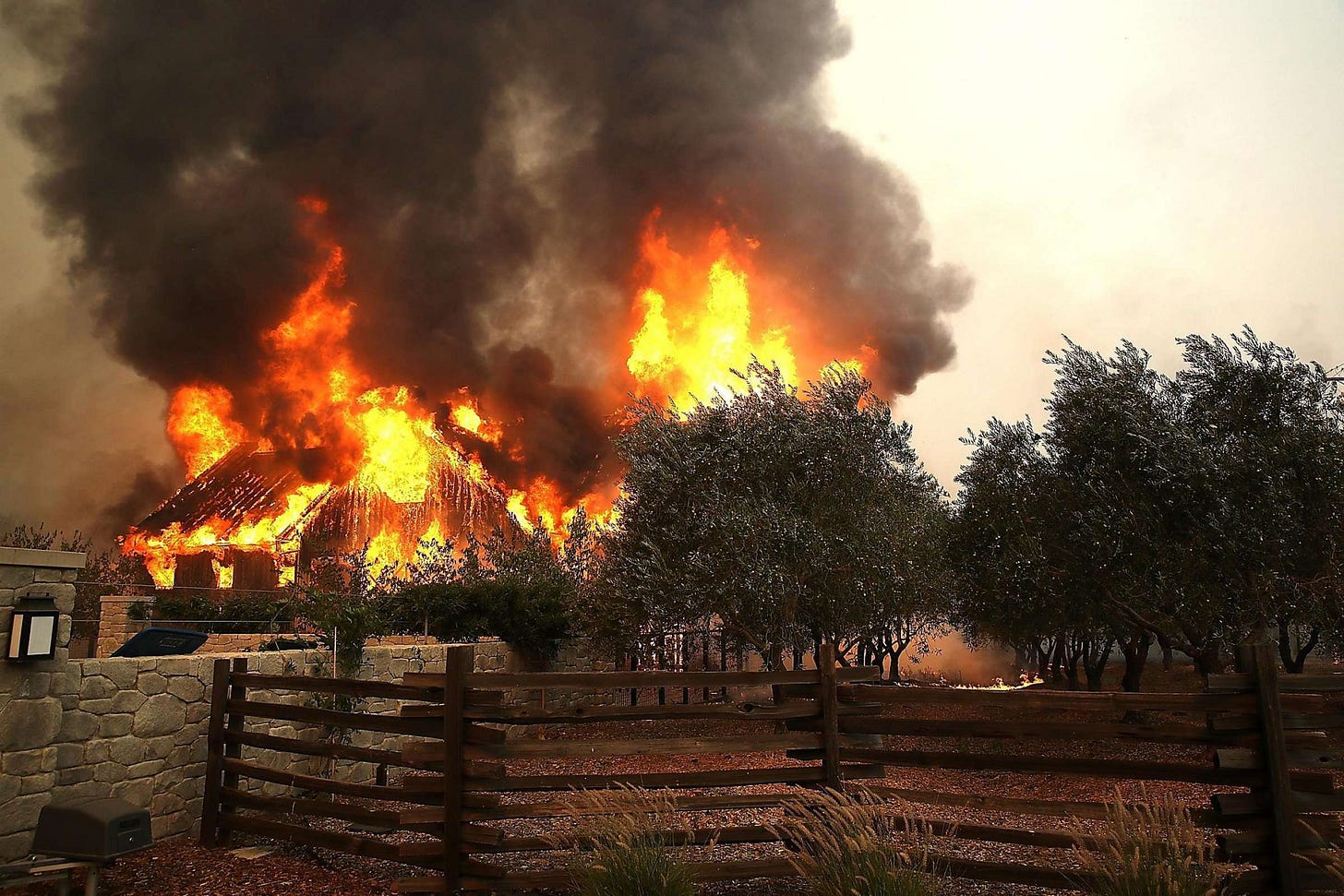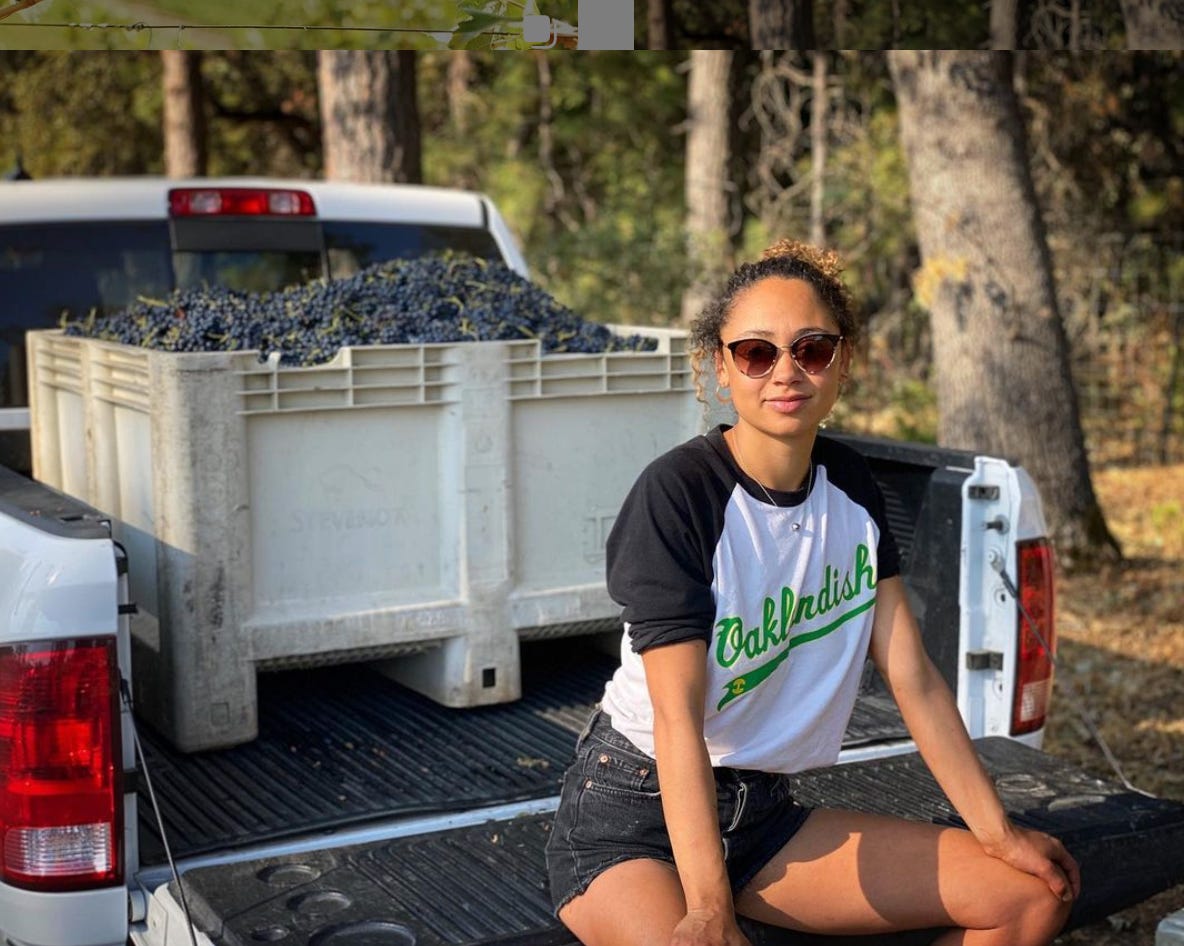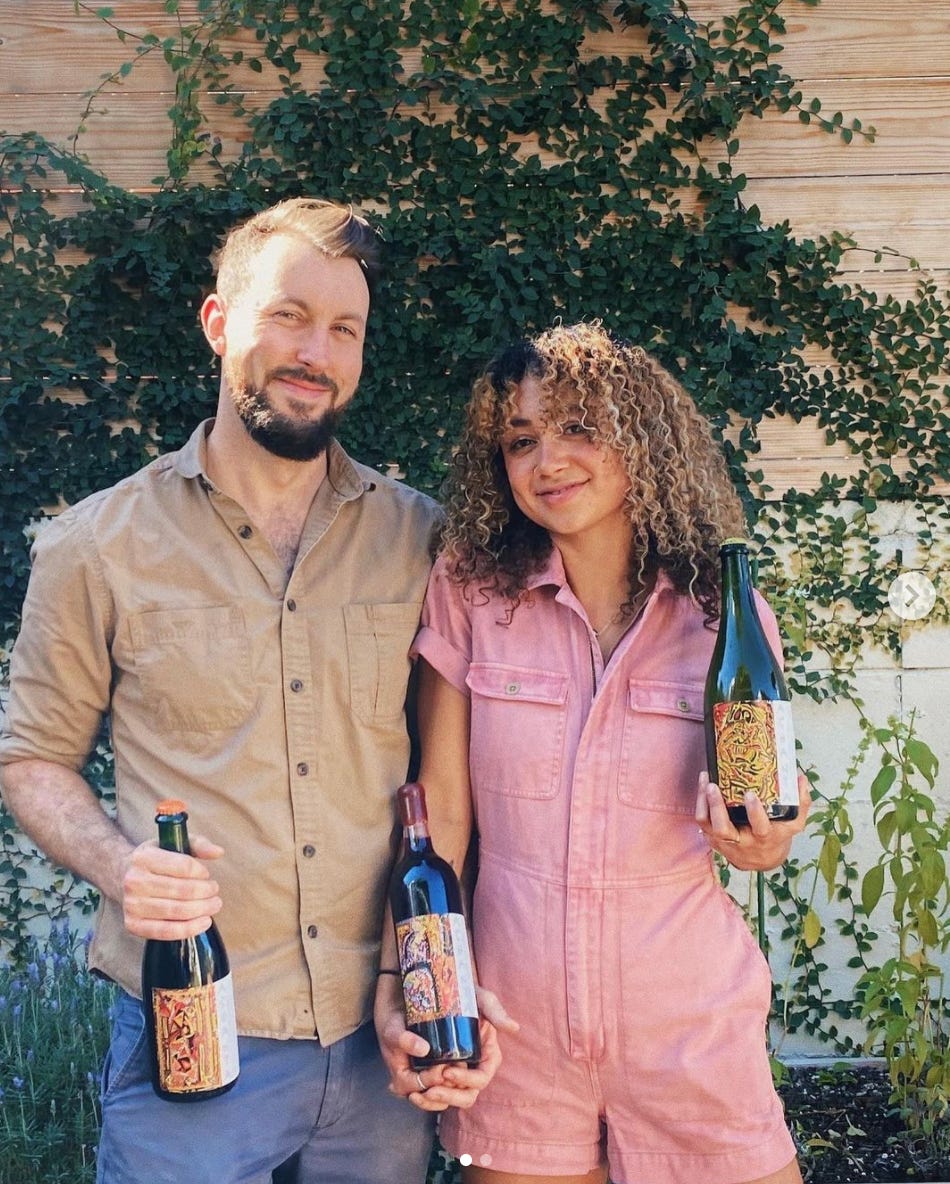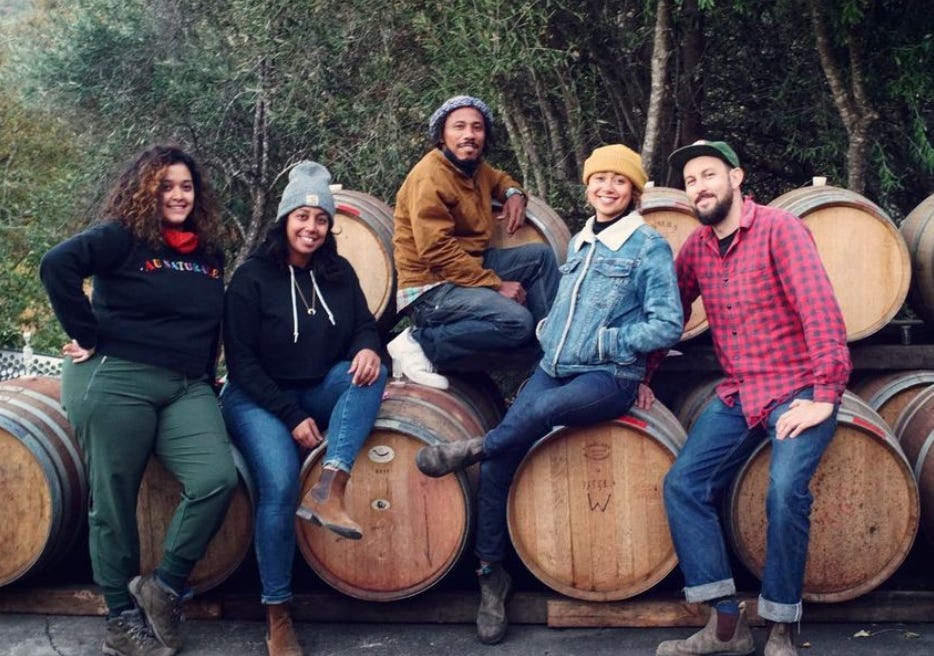The Fizz #17: Chenoa Ashton-Lewis, winemaker at Ashanta Wines, is connecting with her ancestry through vineyards.
Chenoa Ashton-Lewis is a third generation grape grower and upcoming Sonoma winemaker, whose story speaks to regeneration, connection, and belonging.
For the 17th issue of the Fizz, I spoke to Ashanta Wines winemaker Chenoa Ashton-Lewis, over Zoom. Chenoa is an Oakland native farmer and winemaker who helped her family restore their Pinot Noir vineyard that burned in the Nuns Fires. She learned about natural winemaking from her mentor, Tony Coturri, and makes wine at his facility. We spoke about her connection to her ancestry through wine, the impact the Glen Ellen fires had on her family vineyards, and her experience rejuvenating vines thought dead and burned. We also touch on the hidden side of winemaking—legalities and logistics.
Margot: You’re a third generation grape farmer, and you also work with other California growers to source your fruit. Can you give me a sense of all that you’re working with?
Chenoa: My grandparents are from New York and moved to Glen Ellen after living in SF and Oakland in the late 60s. There was a small bohemian, hippie community that they connected with, and they ended up buying property right on the base of Sonoma Mountain in the 1970s. The property was full of orchards and land, and weirdly enough, a pet cemetery. The previous owner was a veterinarian. My grandfather one day was looking out over the pasture and thought about what to do with all of this land—so idealistic! We can’t really do that anymore. [laughs] My grandfather was Sicilian and Jewish, and his grandfather from Sicily used to make wine for his family. That’s our ancestral tie to winemaking. They grafted and planted all their vines on St. George rootstock—one block is Pinot Noir, and the other block is Syrah. It’s been organically farmed from day one.
M: Do you have some old vines on the property then?
C: Yeah, the Syrah is there. The Pinot is mostly gone. In 2019, we made our first wine, and that was from my family’s property. They also made wine for 20 years before the fire—they make it conventionally.
[Chenoa is talking about the devastating 2017 Glen Ellen fire, which destroyed nearly a quarter of homes, along with 192 other buildings, and required residents to evacuate for over two weeks. You can read more about it here. Learn about Direct Relief and California wildfire support here.]

M: Has your influence rubbed off on them at all?
C: [laughs] No. There are four other women on the property. My grandfather passed in 2018, so everyone has their own different views. My mother, I think, is the most curious about it. Natural winemaking, I think, is so aligned with organic farming to me. You have healthy yeast with organic farming, so then why would you want to add anything?
M: You were able to find and revive some of these vines that were destroyed during the fire. What was that process like?
C: In March, my partner Will and I went to Glen Ellen. We spent a lot of time in the vineyard—earlier that year, I had composted the whole vineyard with organic manure, and we were constantly trying to maintain it. We were pulling a lot of blackberry bushes, for example. We’d walk the rows of the Pinot and started to see growth coming from some of the trunks that were cut off, and we kept discovering more and more. One day we were driving to Napa and saw all these abandoned stakes on the side of the road, so we grabbed them—probably 20 stakes to stake up some of these vines we found. We had no idea what we were about to discover.
We walked row by row, aligning our feet—at this point, everything there was completely gone. It was maybe an acre and a half to two acres. Before we restored it, there was really nothing there. We’d walk in a straight line along the row and slowly start pulling out vines that were a range in age—sometimes you’d find like, 9 feet long vines. This was later in the season, maybe April. We pruned them back and staked them, and it ended up taking about two months—it was grueling because you had to search for them. It wasn’t mowed at that point, and we knew mowing was coming up, so we wanted to make sure they weren’t thrashed by the mower. It was incredible to see this life come back. We staked them, and by harvest, my family was able to take half a ton of grapes. Unfortunately, we didn’t make wine with those grapes.
In 2019, Will and I made the first vintage since 2017. It was a Syrah/Pinot Noir (8%) late harvest co-ferment from the family vineyard. We scavenged for the Pinot Noir remains in 2019 but there wasn't much. In 2020, because of the discovery of those seemingly dead vines and the restoration we did in the Pinot Vineyard, my family decided to make wine again in a very different way than I had envisioned.
M: Wow. That’s an incredible experience. I read this article in the New York Times this morning about this experiment where scientists have taken seeds from a bunch of different plants, and they put them in a bottle underground to see how long those seeds will survive and be viable. They’re viable, even after 150 years underground! It’s interesting to think about that and hear your story, because it just shows the amazing resilience of plants.
C: Oh yeah, plants are incredible, and vines are hardy! We think they’re all gentle and super sensitive, but they want to grow! There were some that would even start growing back into the earth—there would be roots coming out of their shoots.
M: I’m interested to hear about your own winemaking philosophy. You’re coming from a winemaking family that’s working conventionally. How’d you come into minimal intervention?
C: It was really interesting growing up around wine, and knowing that was a part of my family’s world. I grew up only drinking their wine. I wasn’t fully aware around what was happening in the cellar until I set off on my own journey in 2018, which was when I was supposed to be helping my grandfather restore the vineyard, but then he passed away. The fire burned their whole property—their home, their vineyard, all the information about the vineyard and the winemaking, everything about previous harvests. The person who had a lot of that information stored in him passed.
In some ways I wouldn’t say there was passed down knowledge. I had to set out on my own journey. I certainly credit a lot of that world to Tony Coturri, where we’re making wine now. He knew my grandfather, and they started planting at similar times. They live just 9 minutes up the hill from my family, and Tony has given me that perspective around being there in the ‘70s and making natural wine. He went a different route than my grandfather did, which I ended up circling back to. My mom tells me that my grandfather did make natural wine before, but it wasn’t very good. [laughs]
That was the amazing full circle—being introduced to Tony, which just started with a tasting that Will and I went to in 2019. Then slowly throughout the year, we were reaching out to him and talking to him. When there were leftover grapes on my family’s vineyard, we thought we’d make wine with them. We’d been to so many natural wine tastings in L.A., but we didn’t know exactly what to do on the winemaking side. We got these grapes and were like, uh what do we do? There’s really not much information out there on how to do it. We just reached out to our resources, and one of them was Tony. We eventually developed a relationship where we could make wine at his spot in 2020. That’s where the most of the information came in—it was incredible. We left L.A. to live on Tony’s vineyard in a tent. We were living and breathing in the vineyard. We’d talk to Tony and go apply those learnings that day.
M: The more folks I talk to in the wine industry about their journeys, the more I realize how much opportunity there is for resource sharing around winemaking or distributing. What resources do you wish that you had?
[If you’re interested in more around resources around winemaking or wine sales/distribution, check out The Fizz interview with Sunshine Foss, owner of Happy Cork wine shop, who is focused on connecting winemakers of color to distribution and sales resources. She’s doing incredibly important work.]
C: One situation definitely comes to mind—when we made the wine on my family’s property, we thought we would be able to sell it. We had no idea that we didn’t make wine at a bonded winery. You think oh that’s basic knowledge isn’t it? No! We didn’t think about that regulation. We couldn’t sell that wine.
[According to the Tax & Trade Bureau, under which wine is regulated, “These laws and regulations require that wine producers qualify their premises as a bonded wine cellar, obtain an FAA basic permit as a producer of wine, pay the applicable excise tax, and obtain a Certificate of Label Approval (COLA) for all wine that is bottled for sale in interstate commerce”.]
M: Wow, that’s tough. So, you make all of your wine at Tony’s facility?
C: Yeah. I think without him and Caleb sharing their resources—there’s a person we talk to at the TTB about our COLA, or having to get the right license, or which website we can use that is compliant. All of that information is so difficult to find, and you can really only do it word of mouth. There’s no groundwork for it. At the end of the day, you need to sell your wine to make money to make more wine. In order to sell your wine, there’s all these logistics you have to go through.
Even in 2020, we weren’t fully aware of all of them—we just had to accumulate information. When I become more experienced, I’d love to help people pin down the steps, what they need, the cost of everything. It gets expensive with the legal side of it. I certainly spend more of my time on logistics and legality than actually making wine.
M: That’s wild—there’s definitely an opportunity here for better access to that information. How do you find the growers for the grapes you buy?
C: A lot of it has been through connections from Tony and Caleb—they have been very open to sharing their resources, which has been incredible. Tony has had long time relationships with a lot of growers—specifically the Testas in Mendecino, whose family planted vines over 100 years ago. They have amazing old dry farmed blocks. The Carignan we used for the rosado and the cider, it was from a 70 year old biodynamic block, which we picked all of.
Caleb Leisure works with a vineyard in the Sierra Foothills, and we were able to get connected with them. The Colombard, though, we found on Wine Business, so we did source grapes from folks we hadn’t known, so we had to meet them and visit the vineyard and see if the relationship would work. Sometimes these growers list one varietal, and they actually have Merlot and Chardonnay interplanted. We ended up making a Merlot Chardonnay co-ferment! We’re super interested in making co-ferments from the same site. There’s all these hidden secrets these growers have.
M: You’re making cider as well—how’d that come about?
C: Tony’s cider is really good. He has a lot of different cider connections in West County, where there are a lot of orchards. He convinced us to try our hand at it, and we sourced apples from Occidental, California, which is out west of Sonoma. They’re all table apples—Gravenstein, Jonathan, and Rhode Island Greening. It was a farmer’s field blend—we got the juice. Tony got the same juice, and we thought well, we can’t make the same thing!
We had been really interested in piquettes, and that week, we knew we were getting Carignan from the Testas for our rosado. We wanted to upcycle those pressed skins, so we added those and Viognier pressed skins to it. It was an experiment—we had never done that before, and it turned out really well. It picks up the color and flavor from the skins. It’s 96% apples, but it’s fuchsia! You get these earthy floral notes. That was one of our most highlighted experiences. It was magical.
M: How’d you make that cider?
C: We got the apple juice and pumped it into oak barrels that have only been used for cider—we had three barrels. We let that ferment until around 5 brix, then pumped it into a big one-ton fermentor bin. After we pressed our Carignan, we took the skins and literally just shoveled them in—maybe about half a ton of the Carignan pressed skins, same with the Viognier. It was a total concoction. At that point, the sugars rose again, and we pumped out the juice after it reached 1.5—we wanted it to be sparkling. We then bottled it under cap, and that’s it.
Now, we decided to disgorge it. We released the first batch at the end of 2020 that was un-disgorged, but we found that we just like it more disgorged. The consumer then got the crispness of it, without the sludge. It’s 9.3% ABV, so it’s a little higher than cider, but it has a great middle ground—it’s super drinkable and it feels light and fresh without bogging you down.
M: I can’t wait to try it.
C: We’ll have some in New York shortly!
M: There’s something unique about working vineyards that your family worked on. In the United States, multi-generational vineyards are hard to find. Do you ever feel that connection to your family in the vineyard?
C: I got into wine because I wanted to connect to my family—I even went to Sicily and spent some time on an organic vineyard out there. It had six varieties of native Sicilian grapes, which was an incredible experience. When I got back to my family’s land, though, especially restoring the Pinot, I really started to connect to Mother Earth. I really actually connected to my Black ancestry. My father is Black, and my family was from New Orleans, and before that, the West Coast of Africa. That was the most profound experience, in that I felt that I was doing the work of my ancestors.
I had, in some way, forgotten that we had been doing the work of the land. Even before we had been enslaved back on our own land, we had been harvesting. We had been growing. We had been planting and saving seeds. I thought there was this innate connection I had to the vineyard and land because of my upbringing and my Sicilian history, but I realized it was far deeper than that. For so many generations, my family had been doing that.
M: That’s really meaningful.
C: Yeah, it was quite emotional, but then everything started to click around how I think the wine industry is starting to really revolutionize. The people who have been working the land the hardest and the longest, with this deep knowledge, those people are now returning and saying hey it makes sense for me to be here, sometimes even more sense than you, and I’m here to reclaim this identity. Through this whole process, I feel like I’m reclaiming this farmer identity, which a couple of years ago, I may have rejected because of that traumatic history of how Black ancestors were taken and forced into slave labor. It’s certainly a sensitive world to approach being a person of color, but processing through those emotions, you start to reconnect and find that they’re right there next to you, cheering you on.
M: You mentioned the wine industry is starting to revolutionize. How do you see the industry changing?
C: Right now, I’m currently a part of an internship with Steve Matthiasson and several other BIPOC bodies, including Chris who has the Two Eighty Project. That gathering of all these Brown folks coming together in the vineyard and learning and getting their hands dirty and having this deep connection to the land and being able to share that, while learning under someone highly regarded—that’s certainly a part of that movement. It’s giving space and access at no cost to the community in order to gain this knowledge and apply it elsewhere.
There’s one person in our group who wants to take this knowledge and take it to his homeland, the Dominican Republic, to plant vines. That’s where it’s starting to shift—the educational access that is prioritizing BIPOC. That ranges from Industry Sessions to this internship to the Two Eighty Project—welcoming, inviting, uplifting.
M: Where do you find the most joy in what you do?
C: I love being in the dirt. I feel like it’s connecting back to that inner child that you lose sight of for so many years. Every time I go back into the vineyard, despite all the other stress, watching something grow and facilitating in that growth allows me to be so much more in tune with what’s going on around me. You notice the birds, the caterpillars, the worms, the rattlesnakes. You just start to see the infinity sign moving.
In the cellar, everything we made in 2020, we had never made before—it’s all new. We’re trying new things, and there are magical moments. We got our first batch of Colombard in late August, and as we’re processing it, it has this thick mucous-y color. We turned it into pét-nat, and it’s so clear and crisp and light golden. Those are amazing moments—watching the wine transform throughout time and seasons. Each time we’re asking questions about what happened and why, but there’s nothing we can do about it—we don’t add anything, no sulfites either. That’s the philosophy we were introduced to. There’s a magic in the growth of these organisms—what’s inside of the bottle is alive.
M: It sounds like you have a deep connection with the work that you’re doing. How did you choose the name Ashanta?
C: It’s actually a blend of mine and Will’s last names. It’s also derived from a form of thank you in Ghanaian, and it pays homage to the Ashanti tribe. My family was from that region, so it’s certainly connecting back to ancestry, and a combination of me and Will joining together and creating this project.
M: Thanks so much for your time with me. I hope we’ll be able to cheers in person soon!
————
Non-profit pairing: Chenoa supports Fair Fight, an important organization that stands to “promote fair elections in Georgia and around the country, encourage voter participation in elections, and educate voters about elections and their voting rights”. Donate to this impactful non-profit here.
You can learn more about, and shop for Ashanta Wines on their website, and stay up-to-date by following them on Instagram.
Liked this interview? Hit subscribe and help me record more information about exciting winemakers, American history, and so much more. Paid subscriptions are just $5/month or $50/year, and 20% goes to St. Francis House. If you share this piece with a friend, it would mean a lot. Thanks for reading! You can follow me on Instagram here, and support my upcoming American wine business here.









